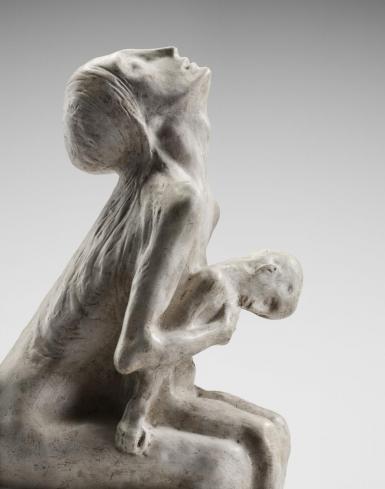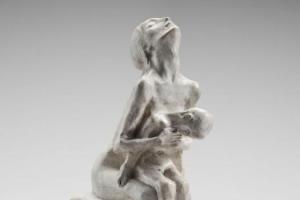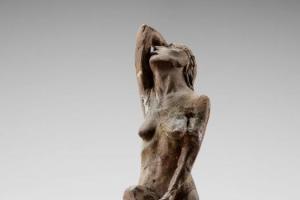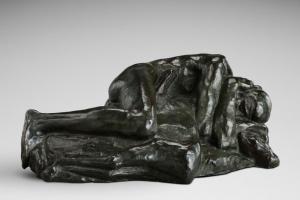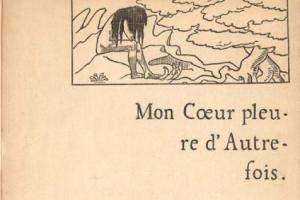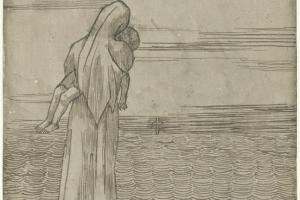Sorrow
Minne felt intensely involved with the social problematic of his time, an emotion that he shared with artists such as Van Gogh or Munch, and that stood far afield from the rather sentimental vision of the 19th-century romantic. In the gripping sculptures of Mother Grieving over her Dead Child and Mourning Mother with two Children (inter alia, Brussels, KMSKB), as well as in the same-named drawing, he brings the emotion to expression, or as his friend Maurice Maeterlinck expressed it: "George Minne is the great depicter of sorrow." Mother Grieving over her Dead Child is perhaps the most dramatic sculpture in the whole of Minne's oeuvre. Making the Piet� motif profane from the Christian iconography gives the work a universal character. At the same time, the concept of a figure, sitting on a cubical block recalls the old, Egyptian art. In addition, the drawing of the sun on the side of the block also suggests a hieratic sculpture of a pharaoh.
Minne exhibited Mother Grieving over her Dead Child, along with the sculpture group Mourning Mother with two Children, for the first time in the 1890 at Les XX in Brussels. The sculptures elicited harsh critique from the conservative-minded press, who compared them with "droll fetuses, fetishes from wild tribes." Appreciation came from critics such as Eugène Demolder, who had an eye for the innovation of Minne's sculptures, "...so simple and from a thorough elementary humanity." August Vermeylen articulates his deep feeling upon seeing the sculptures in 1893 in the newspaper Van Nu en Straks: "It is now four years ago that I saw them, but the high and angular, stiffly lined figures still touch my spirit. There was all at once the sorrow of the ages, like a cry." Thus begins August Vermeylen his eulogy of Minne's sculptures. And, he continues, "Sudden revelation of an art quite unusual: the symbolic-simplification of anatomies-if hewn from rocks the greatness of Egyptian sculptures-executed with the moving and suffering hand of the most naïve Gothics."
Versions of Mother Grieving over her Dead Child exist in plaster, bronze and marble. In addition to a version in plaster, the MSK has a preparatory study in terracotta. This is the only study in terracotta that is known by the hand of the artist. In the rather complicated composition of Mourning Mother with two Children, we see for the first time an attitude of self-preservation and shielding oneself from the outside world, an attitude that Minne will later adapt in sculptures such as Small Injured Figure, Man Grieving over a Dead Deer and different versions of the kneeling figures. The figure of the grieving woman, however, without children, Minne takes up again in the cover design for the collection of poetry, Mon coeur pleure d'autrefois by Grégoire Le Roy. There is a version in plaster and in bronze of the sculpture group Mourning Mother with two Children.
From 1889 dates a drawing in ink and aquarelle with a veiled woman seen from the back. She carries a lifeless child in her arms and stands in the water, with her gaze on the cross in the distance. Around 1895, Minne takes up again the figure of the mother with the child in a pencil drawing and a woodcut for the poem, Le Meunier from Les Villages illusoires by Emile Verhaeren. Worthy of note is the resignation in the attitude of the woman and the serenity in the expression, which stands in stark contrast with the dramatic vision on the events in Mother Grieving over her Dead Child. (For instance in the Museum Boijmans Van Beuningen in Rotterdam)
The pencil drawing Mourning Mother from 1890, one of the most reproduced drawings by Minne, is the last in a series of works focusing on the grief of a mother over the painful loss of a child. The presentation probably has to do with the youthful memory of Minne during the Franco-Prussian war of 1870: the image of a French war refugee who carried her dead child in her arms, most likely stuck with him. It is one of the few works that is discussed in detail by his contemporaries. Verhaeren compares the work to the art of the Pre-Raphaelites and Vermeylen provides a precise description of it in the newspaper De Vlaamse School: "The rags, the hair hanging down, the bony hands, the crooked bodies, the dreadful crying eyes, all of that pitiful, pathetic combination speaks of the misery of our suffering mind and of our suffering flesh". A few months later Vermeylen published the work in the avant-garde newspaper Van Nu en Straks, of which he was one of the founders.
Helke Lauwaert

